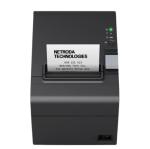VirtualESCPOSDevice
| VirtualESCPOSDevice | |
|---|---|
| Developer | Netroda Technologies |
| Type | Graphics Device and Imaging Library |
| Purpose | Receipt generation Printing Receipt conversion |
| Compatibility | ESC/POS (Epson) NCR (Partial support) |
| Initial Release | 2014 with ES/S-B J1 Positive |
| Current Version | 1.5.0 (20 Apr. 2025) |
| License | N.P.A.L. |
| Platform | Extensible Services / Server |
| Derived from |
|
| Associated | VirtualESCP2Device |
VirtualESCPOSDevice (as in Virtual ESC/POS Device) is a collection of classes and functions, used to generate, print and convert descriptive datastreams (directives) into HTML, Bitmap Images and PDF together with a Native EPSON ESC/POS Output stream.
Contents
Overview
VirtualESCPOSDevice is a versatile software component designed to facilitate the generation, printing, and conversion of descriptive datastreams—referred to as directives—into multiple output formats, including HTML, bitmap images, PDF, and native EPSON ESC/POS streams. It serves as an abstraction layer that allows developers to work seamlessly with a wide range of receipt printer models, including legacy and limited-functionality devices.
VirtualESCPOSDevice supports all common barcode and QR code symbologies, ensuring consistent output regardless of the specific capabilities of the connected printing hardware.
For the associated Full-page line printer devices from various manufacturers, the VirtualESCP2Device implementation exists.
Technical
Symbol and Barcode Rendering in VirtualESCPOSDevice
VirtualESCPOSDevice leverages device-independent symbol libraries to ensure accurate and consistent rendering of barcodes and symbols across all supported output formats, regardless of the target printer's native capabilities. This approach allows the system to overcome limitations commonly found in older or basic ESC/POS devices, which may lack built-in support for modern symbologies or advanced rendering features.
When a directive specifies a barcode, QR code, or other symbol, VirtualESCPOSDevice performs the following process:
- Parsing and Validation
The directive is parsed to extract the symbol type, data content, and formatting instructions (e.g., size, alignment, error correction level).
- Library-Based Rendering
Instead of relying on the ESC/POS device to interpret and generate the symbol, VirtualESCPOSDevice uses an integrated set of high-performance, device-agnostic rendering libraries. These libraries generate a high-fidelity bitmap representation of the specified symbol.
- Image Embedding
The rendered bitmap is then seamlessly embedded into the overall output stream—whether for PDF, HTML, or native ESC/POS. In the case of ESC/POS output, the image is converted into raster format commands that the printer can interpret, effectively "printing" the symbol as an image.
- Output Formatting and Optimization
The final datastream is optimized for size and compatibility. For ESC/POS devices, this includes compression and command sequencing tailored to the device's feature set.
By offloading the symbol rendering to a controlled, consistent software layer, VirtualESCPOSDevice ensures uniform output across platforms while maximizing compatibility with the widest range of printers. This strategy also simplifies the development process, as developers do not need to handle the complexity of conditional device support or proprietary command sets for individual symbologies.
Specification limits
File size is not limited to a certain size, the header size however must be in the range of 196 to 4096 bytes, given the fact that for the necessary metadata this is absoloutely sufficient.
The actual Application contents are stored in the PK-Format (ZIP), the support for TAR has been dropped before the initial release but might enter at a later point in time.
The encoders (i.e. smpak) are responsible for maintaining proper header size, thus ensuring no malformed header may encoded. The header size limits (FastAccess) have been set to current specifications (2023)
Generation
SignMatic Application Packages can be created using the command line tool smpak (delivered with SignMatic Studio). The application folder requires a valid build information file (example below) to be present in the base directory named "build".
A Single application must contain
- A valid and unique AppId
- A 3-level version
- The Buildfile version
- The minimum required SignMatic version
- Name
- Description
- Icon
- Theme Color
This file also represents vaguely the informations provided by each application besides their main archive.
{
"appId" : "a4bc7782c208449095bf54d5d495aad9",
"appVer" : [1,0,0],
"bVer" : 1.0,
"sMinReq" : [1,1,7280],
"appName" : "Airport",
"appDescription" : "This demo features a airport information screen, to display live data of passenger flights on your SignMatic.",
"vendor" : "Netroda Technologies",
"website" : "https://netroda.com/a/k/products/ess-i/signmatic/demo/",
"privacyPolicy" : "https://netroda.com/a/k/products/ess-i/signmatic/privacy",
"termsOfService" : "https://netroda.com/a/k/products/ess-i/signmatic/terms",
"imageIcon64" : "data:image/png;base64,iVBORw0KGgoAAAANSUhEUgAAADYAAAA2CAYAAACMRWrdAAAAAXNSR0IArs4c6QAAAARnQU1BAACxjwv8YQUAAAAJcEhZcwAADsMAAA7DAcdvqGQAAAPRSURBVGhD7ZlLaBNRFIZb67MiCKLgY6VWceNCimIXVUTd2YeCunArRcFHsYjSRVUQpAsftSj43HQl4qMiVXSjoAtBVxYEpYuCCkIVlBicSaLfdP7GpJkk80xTzQc/kzv3nP/cO/dOkkmqKlSoUOG/IJVKNaDryWTyKcdONEtdkxcm0YVSvzOg+YxDrULCAdMZehk51DprTyWXRCJxSGHBodAm9I4tcYVjvU5HAv7nNAdH6L+j0GDgtRGz77atDe0BtJ2X0xUWCnjmXakxiDmtcP/gY03qh22ZC31vUUcsFlusFN/gU3ClLNgx34hbohR/YNCM4vIsCAVHiL2EfG1T8oqulGhRin8o1oYMGbqCeItHaAdNV9uU2KIrZUHcXqUEB7M16LW8PUHeIOpAi2SXA32uVoq4/UoJD3xrMb5ol/AOuSNs1cscs7YpbbcrtU8p0UCB3eiL6vmC/AHTNFs4dutUQYgLf6WciMfjyyj2RHUjhTrRrtR4qFlN0ZN2+Wgo2Uo5QfGt3DtDGkto4BveVya/MIgFTO6WxhQY/NplXR4woAPop8bnGS5OgvyDsisvDMOoZ3BvNFZPkGeg5bIqPxjcbNSLYhqza1i1btmUL0ysX+N1DTnDqHyfkHkQtJ58TY3XE+Q1yaa8YGBdGqMvyA/nITJMuEdOaHy+YWIxFPjZLjSCrlQmbOXy+Cxzu1LEvdTLgnCRrMekatlPDG5XirgjHKZq0EUhbp1KlB63K8XWOqYU60KsJS+prrwQ16uU0kJht/dUelJjcO6M3ZUf/D+hOUoJDmbWw+QFLmoPxxuoD91GD9Bj9By9Uv2CZK5UJnTNxGPQjsoP+buUEgyKtcszDBwnNQa1GhWXF2IeKtwfeNRg0mnbBSffSo2Hmj1KcYT+XxyWKtw7GKxHQ6joTe0CV5OyoJ71hfmD8hyh/7jCvUN+DbL2fZ1pms3Wux26T/s9cvW7InFJtyuVCXlbZOEI47DuxSkKDwcMp1F4JWpFp1A/cvwpgPN3leYZBn9VNo7g3ajQ6KDIPPRZNdMwuPMK8Qzpc/Ectp1yoe+aQqOFQi9UMw3nAv0DQn6TrHKg7ytaqNDooMhN1czE8/01Hnz75JWDYRgbFBYdDOCo6qXhXODfAfGYj3K2OedK822fQttUMw3n9qg7EPjslOUotA+rK3ootgplPfrTblZ3YPC6J8/SPpdR0Ppg/Tg6o79sVndg8K5DbWqWFgpnvTPSblDX5IaJZL0z0l6hrskNE+nQnKxJlfbvnihhMq2a1MT93RMFTGj1P7VSFSpUKEBV1R+M2kmQTyMt+AAAAABJRU5ErkJggg==",
"color" : "486ADA"
}
Support
Support for specific applications is usually carried out by the application vendor, there is a option to reference a URL to the application vendor's product website for help.
Version history
| Revision | Released | Lifecycle | Compatibility |
|---|---|---|---|
| 1.0.0 | 08 Feb. 2023 | Not announced | 1.1.7281+ |
